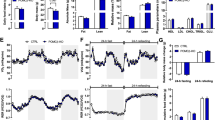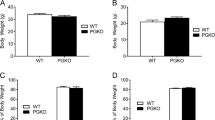Abstract
Previous studies have proposed roles for hypothalamic reactive oxygen species (ROS) in the modulation of circuit activity of the melanocortin system1,2. Here we show that suppression of ROS diminishes pro-opiomelanocortin (POMC) cell activation and promotes the activity of neuropeptide Y (NPY)- and agouti-related peptide (AgRP)-co-producing (NPY/AgRP) neurons and feeding, whereas ROS-activates POMC neurons and reduces feeding. The levels of ROS in POMC neurons were positively correlated with those of leptin in lean and ob/ob mice, a relationship that was diminished in diet-induced obese (DIO) mice. High-fat feeding resulted in proliferation of peroxisomes and elevated peroxisome proliferator–activated receptor γ (PPAR-γ) mRNA levels within the hypothalamus. The proliferation of peroxisomes in POMC neurons induced by the PPAR-γ agonist rosiglitazone decreased ROS levels and increased food intake in lean mice on high-fat diet. Conversely, the suppression of peroxisome proliferation by the PPAR antagonist GW9662 increased ROS concentrations and c-fos expression in POMC neurons. Also, it reversed high-fat feeding–triggered elevated NPY/AgRP and low POMC neuronal firing, and resulted in decreased feeding of DIO mice. Finally, central administration of ROS alone increased c-fos and phosphorylated signal transducer and activator of transcription 3 (pStat3) expression in POMC neurons and reduced feeding of DIO mice. These observations unmask a previously unknown hypothalamic cellular process associated with peroxisomes and ROS in the central regulation of energy metabolism in states of leptin resistance.
This is a preview of subscription content, access via your institution
Access options
Subscribe to this journal
Receive 12 print issues and online access
$209.00 per year
only $17.42 per issue
Buy this article
- Purchase on Springer Link
- Instant access to full article PDF
Prices may be subject to local taxes which are calculated during checkout




Similar content being viewed by others
Change history
16 September 2011
In the version of this article initially published, the top electrophysiological trace of Figure 4a was inadvertently repeated as the bottom electrophysiological trace of Figure 4b. The scientific conclusions of the paper were not affected by the error. The error has been corrected in the HTML and PDF versions of the article.
References
Andrews, Z.B. et al. UCP2 mediates ghrelin's action on NPY/AgRP neurons by lowering free radicals. Nature 454, 846–851 (2008).
Horvath, T.L., Andrews, Z.B. & Diano, S. Fuel utilization by hypothalamic neurons: roles for ros. Trends Endocrinol. Metab. 20, 78–87 (2009).
Gropp, E. et al. Agouti-related peptide–expressing neurons are mandatory for feeding. Nat. Neurosci. 8, 1289–1291 (2005).
Luquet, S., Perez, F., Hnasko, T. & Palmiter, R. NPY/AgRP neurons are essential for feeding in adult mice but can be ablated in neonates. Science 310, 683–685 (2005).
Cone, R.D. Studies on the physiological functions of the melanocortin system. Endocr. Rev. 27, 736–749 (2006).
Gao, Q. & Horvath, T.L. Neurobiology of feeding and energy expenditure. Annu. Rev. Neurosci. 30, 367–398 (2007).
Halaas, J.L. et al. Physiological response to long-term peripheral and central leptin infusion in lean and obese mice. Proc. Natl. Acad. Sci. USA 94, 8878–8883 (1997).
Bjørbaek, C., Elmquist, J.K., Frantz, J.D., Shoelson, S.E. & Flier, J.S. Identification of SOCS-3 as a potential mediator of central leptin resistance. Mol. Cell 1, 619–625 (1998).
Horvath, T.L. et al. Synaptic input organization of the melanocortin system predicts diet-induced hypothalamic reactive gliosis and obesity. Proc. Natl. Acad. Sci. USA 107, 14875–14880 (2010).
Pinto, S. et al. Rapid re-wiring of arcuate nucleus feeding circuits by leptin. Science 304, 110–115 (2004).
Pal, R. & Sahu, A. Leptin signaling in the hypothalamus during chronic central leptin infusion. Endocrinology 144, 3789–3798 (2003).
Leloup, C. et al. Mitochondrial reactive oxygen species are required for hypothalamic glucose sensing. Diabetes 55, 2084–2090 (2006).
Benani, A. et al. Role for mitochondrial reactive oxygen species in brain lipid sensing: redox regulation of food intake. Diabetes 56, 152–160 (2007).
Dikalov, S., Losik, T. & Arbiser, J.L. Honokiol is a potent scavenger of superoxide and peroxyl radicals. Biochem. Pharmacol. 76, 589–596 (2008).
Parton, L.E. et al. Glucose sensing by POMC neurons regulates glucose homeostasis and is impaired in obesity. Nature 449, 228–232 (2007).
Schrader, M. & Fahimi, H.D. Peroxisomes and oxidative stress. Biochim. Biophys. Acta 1763, 1755–1766 (2006).
Gao, Q. et al. Anorexigenic estradiol mimics leptin's effect on re-wiring of melanocortin cells and Stat3 signaling in obese animals. Nat. Med. 13, 89–94 (2007).
Green, S. PPAR: a mediator of peroxisome proliferator action. Mutat. Res. 333, 101–109 (1995).
Bernardo, A. & Minghetti, L. PPAR-γ agonists as regulators of microglial activation and brain inflammation. Curr. Pharm. Des. 12, 93–109 (2006).
Yu, X. et al. Activation of cerebral peroxisome proliferator–activated receptors γ exerts neuroprotection by inhibiting oxidative stress following pilocarpine-induced status epilepticus. Brain Res. 1200, 146–158 (2008).
Thaler, J.P. & Schwartz, M.W. Minireview: Inflammation and obesity pathogenesis: the hypothalamus heats up. Endocrinology 151, 4109–4115 (2010).
Cullingford, T.E. et al. Distribution of mRNAs encoding the peroxisome proliferator–activated receptor α, β, and γ and the retinoid X receptor α, β, and γ in rat central nervous system. J. Neurochem. 70, 1366–1375 (1998).
Sarruf, D.A. et al. Expression of peroxisome proliferator-activated receptor-γ in key neuronal subsets regulating glucose metabolism and energy homeostasis. Endocrinology 150, 707–712 (2009).
Kim, T.H. et al. Interrelationship between liver X receptor α, sterol regulatory element-binding protein-1c, peroxisome proliferator-activated receptor γ, and small heterodimer partner in the transcriptional regulation of glucokinase gene expression in liver. J. Biol. Chem. 284, 15071–15083 (2009).
Belsham, D.D. et al. Ciliary neurotrophic factor recruitment of glucagon-like peptide-1 mediates neurogenesis, allowing immortalization of adult murine hypothalamic neurons. FASEB J. 23, 4256–4265 (2009).
Poplawski, M.M. et al. Hypothalamic responses to fasting indicate metabolic reprogramming away from glycolysis toward lipid oxidation. Endocrinology 151, 5206–5217 (2010).
Puri, V. et al. Cidea is associated with lipid droplets and insulin sensitivity in humans. Proc. Natl. Acad. Sci. USA 105, 7833–7838 (2008).
Heid, H.W. et al. Adipophilin is a specific marker of lipid accumulation in diverse cell types and diseases. Cell Tissue Res. 294, 309–321 (1998).
Kouidhi, S. et al. Peroxisome proliferator–activated receptor-γ (PPAR-γ) modulates hypothalamic Trh regulation in vivo. Mol. Cell. Endocrinol. 317, 44–52 (2010).
Festuccia, W.T. et al. Peroxisome proliferator–activated receptor-γ–mediated positive energy balance in the rat is associated with reduced sympathetic drive to adipose tissues and thyroid status. Endocrinology 149, 2121–2130 (2008).
Lu, M. et al. Brain PPAR-γ promotes obesity and is required for the insulin-sensitizing effect of thiazolidinediones. Nat. Med. 17, 618–622 (2011).
Ryan, K.K. et al. A role for central nervous system PPAR-γ in the regulation of energy balance. Nat. Med. 17, 623–626 (2011).
Takahashi, K.A. & Cone, R.D. Fasting induces a large, leptin-dependent increase in the intrinsic action potential frequency of orexigenic arcuate nucleus neuropeptide Y/Agouti-related protein neurons. Endocrinology 2005, 1043–1047 (2005).
Hoepfner, D. et al. Contribution of the endoplasmic reticulum to peroxisome formation. Cell 122, 85–95 (2005).
Tabak, H.F. et al. Formation of peroxisomes: present and past. Biochim. Biophys. Acta 1763, 1647–1654 (2006).
Ozcan, L. et al. Endoplasmic reticulum stress plays a central role in development of leptin resistance. Cell Metab. 9, 35–51 (2009).
Finkel, T. & Holbrook, N.J. Oxidants, oxidative stress and the biology of ageing. Nature 408, 239–247 (2000).
Acknowledgements
We thank J.M. Olefsky, Department of Medicine, University of California–San Diego, for generating and providing brain-specific PPAR-γ–knockout mice and B.B. Lowell, Beth Israel Deaconess Medical Center, for providing breeding pairs of UCP2-knockout mice. This work was supported by US National Institutes of Health (NIH) grants DK084065 (S.D.) and DK080000 and OD006850 (T.L.H.) and by American Diabetes Association grant 7-08-MN-25 (T.L.H.). This work was also supported by NIH grants DK089098 (X.Y.), DK072033 (C.V.M.) DK090320 and DK052989 (M.W.S.) and AR47901and P30 AR42687 (J.L.A.).
Author information
Authors and Affiliations
Contributions
S.D. and T.L.H. developed the conceptual framework of the study, designed the experiments, conducted studies, analyzed data and wrote the paper. Z.-W.L., J.K.J., M.O.D., H.-B.R., E.K., S.S., K.K., E.G., D.A.S. and M.S. conducted experiments. J.L.A. initiated studies with honokiol and provided reagents. C.V.M. designed and supervised in vitro cell signaling studies. M.W.S. designed studies on PPAR-γ–knockout mice. D.D.B. provided POMC and AgRP cell cultures and helped design experiments. A.M.B. provided reagents and advised on signaling aspects of the work. X.Y. and X.-B.G. supervised experiments and analyzed data.
Corresponding authors
Ethics declarations
Competing interests
The authors declare no competing financial interests.
Supplementary information
Supplementary Text and Figures
Supplementary Figures 1–5 (PDF 2177 kb)
Rights and permissions
About this article
Cite this article
Diano, S., Liu, ZW., Jeong, J. et al. Peroxisome proliferation–associated control of reactive oxygen species sets melanocortin tone and feeding in diet-induced obesity. Nat Med 17, 1121–1127 (2011). https://doi.org/10.1038/nm.2421
Received:
Accepted:
Published:
Issue Date:
DOI: https://doi.org/10.1038/nm.2421
This article is cited by
-
Brain nuclear receptors and cardiovascular function
Cell & Bioscience (2023)
-
High sucrose consumption decouples intrinsic and synaptic excitability of AgRP neurons without altering body weight
International Journal of Obesity (2023)
-
Exploring the precision redox map during fasting-refeeding and satiation in C. elegans
Stress Biology (2023)
-
CHD7 regulates bone-fat balance by suppressing PPAR-γ signaling
Nature Communications (2022)
-
The redox language in neurodegenerative diseases: oxidative post-translational modifications by hydrogen peroxide
Cell Death & Disease (2021)



